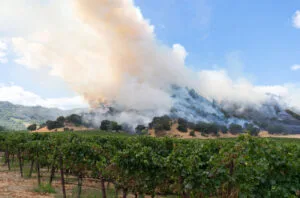Wildfire smoke in northern California in 2018. Several factors can determine whether a vineyard is affected, however.
Researchers recently reported promising results after testing a new way of removing volatile compounds responsible for causing unpleasant smoke taint aromas and taste in wine.
While some volatile compounds occur naturally in grapes and contribute to appealing aromas in the glass, those absorbed from wildfire smoke can lead to wines with ‘a disagreeable smoky, ashy or medicinal character that compromises quality and reduces value’, said the researchers.
Wildfires and related smoke drift have caused challenges for winemakers in several vineyard regions around the world, amid evidence that climate change is contributing to more extreme weather events.
Current techniques to remove volatile smoke taint compounds tend to also extract desirable compounds that contribute to a wine’s bouquet, colour and flavour, said researchers in the American Chemical Society’s Journal of Agricultural and Food Chemistry.
They tried a new method of ‘fishing’ unpleasant volatile phenols out of wines by using molecularly imprinted polymers (MIPs) – synthetic materials that can bind to one or more target compounds.
Beads of MIPs were added to the liquid, either floating freely or in muslin or mesh bags. Wines then underwent chemical analysis and were tasted-tested by experts, as well as students, staff and members of the public.
‘Despite some impact on other aroma volatiles and red wine colour, the findings demonstrate that MIPs can ameliorate smoke-tainted wine,’ said the researchers in their study paper.
They also found that MIPs could







